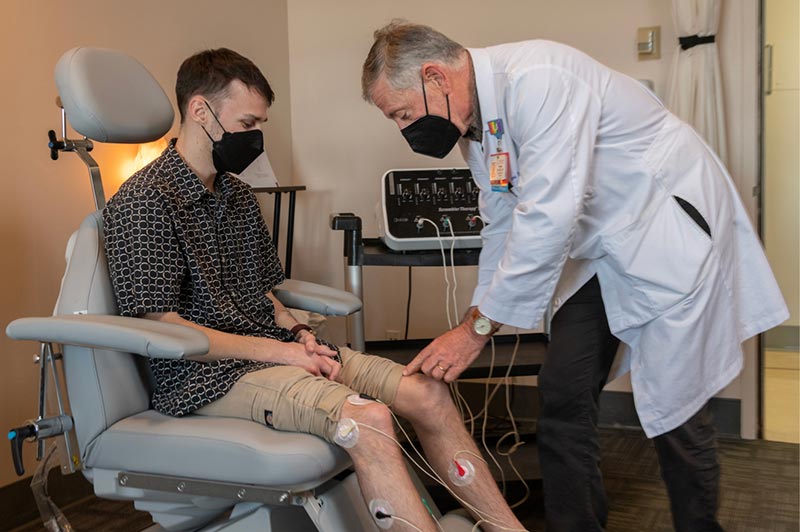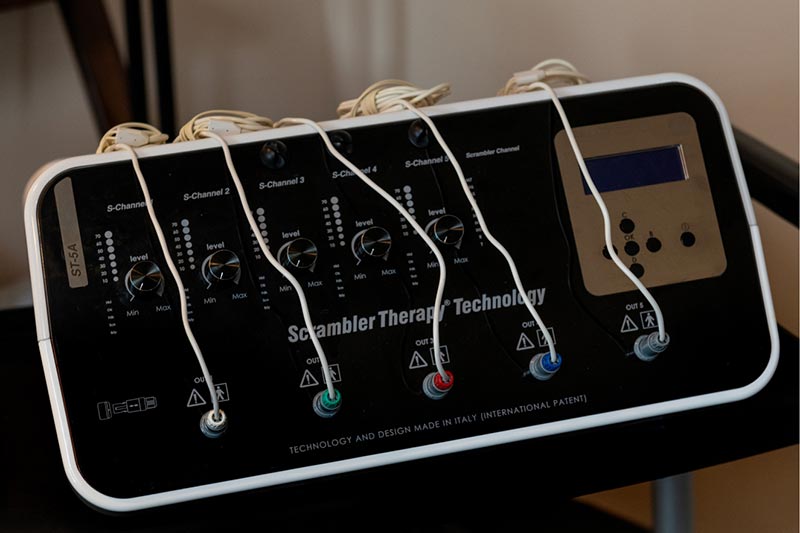Scrambler is an FDA approved medical device. It is used for the treatment of chronic neuropathic pain that has not responded adequately to standard approaches such as medication, physical therapy, injections, surgery, etc. The link below will take you to a recent review article on Scrambler in the New England Journal of Medicine.
Download Scrambler Therapy Flyer
The Scrambler Therapy device produces very small electrical currents that are transmitted into the skin via disposable EKG electrodes placed around (but not on) the painful area. The Scrambler signal is thought to provide “non-pain” information to nerve fibers that have been receiving “pain” messages, reducing the patients experience of pain.

Photo by Joshua Sudock

Scrambler therapy cannot cure or correct the underlying condition that is causing the pain. It treats chronic neuropathic pain as a separate and distinct problem by changing the message the nerves are sending to the brain from “pain” to “non-pain”.
Scrambler is also unlikely to eradicate pain permanently. Most pain will return at some point, but patients can get relief that lasts for months or longer. That time frame may vary based on the individuals response to therapy. When pain reoccurs, we can then provide booster therapy. This treatment is usually 2-3 additional sessions to regain previously experienced pain reductions.
Yes. See below:
Initially, the patient may feel a very mild pinch/bite/prickly sensation. As the intensity of the stimulation is gradually increased, this changes to a vibration/buzz/hum/pulsing sensation.
The patient sites comfortably in a chair. The treatment is not painful. Pain relief is expected during the first and all subsequent sessions of Scrambler and is an important way for the practitioner to determine appropriate placement of the electrodes.
If there is significant discomfort at any time during a Scrambler treatment session the practitioner will turn the device off and reposition the sticky electrode.
Initial scrambler therapy is usually involves a total of 10 daily sessions given several days per week. As the benefits take hold, the pain relieving effects of Scrambler last longer and longer between sessions.
Some individuals may need fewer than 10 sessions and some may need more than 10 sessions, depending on the response to treatments. A course of Scrambler treatment is considered complete when pain relief lasts a full 24 hours or longer after a session.
Each session lasts 35-45 minutes on the machines once electrodes are placed.
Appointments are scheduled for about an hour.

Photo by Joshua Sudock
We expect that Scrambler may make a significant difference for may patients with chronic pain, but it is not a substitute for continued longitudinal pain care and a relationship with a provider. Patients will remain under the care of their primary care physicians and/or pain management specialists while undergoing Scrambler treatment. We will work with patients’ pain management team to integrate Scrambler therapy into their ongoing pain management plan.
Although Scrambler has been FDA-approved since 2009 as safe and effective for use in the U.S., it is still regarded by regulators and payors as investigational. Therefore, it is not covered by Medicare or most commercial insurance companies. At UCLA, the Scrambler procedure charge is $287.00/session, with no expectation of insurer coverage. You will be required to pay the procedure charge at the time of each service. If your insurer pays some amount on the bill for the Scrambler procedure, UCLA will reimburse you that amount upon receiving payment from the insurer. Both Medicare and commercial insurers generally DO pay for the separate physician professional fees; for these services, you are only responsible for co-pays, per your insurance policy.
Scrambler therapy is being provided on a consultation basis in the UCLA Semel Institute Neuromodulation Division TMS Clinic.
Referring clinicians and their patients can call 310-825-4612 or email [email protected] for more information. The Neuromodulation Division’s website will soon have Scrambler information posted there as well: https://tms.ucla.edu